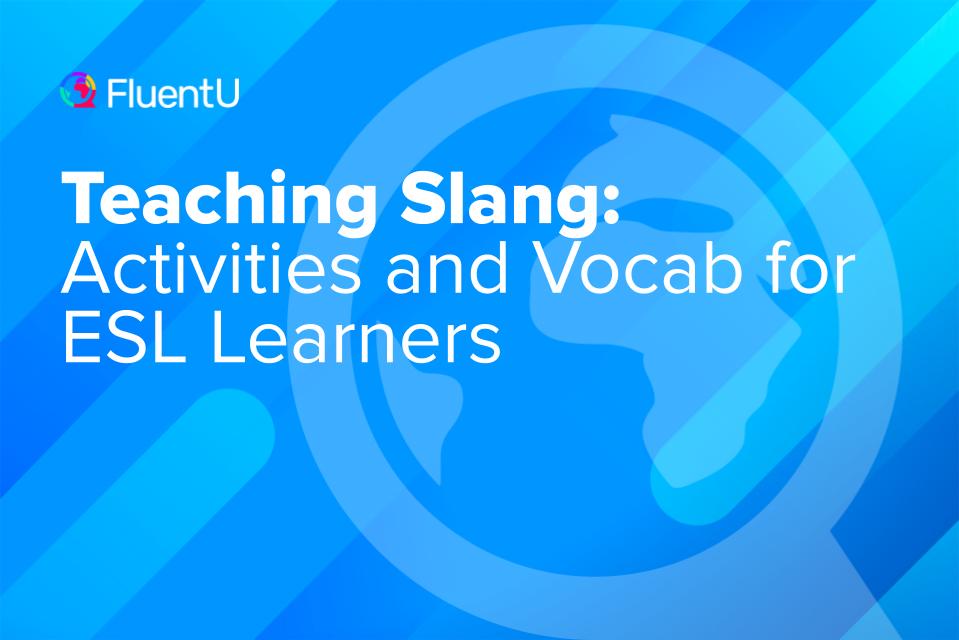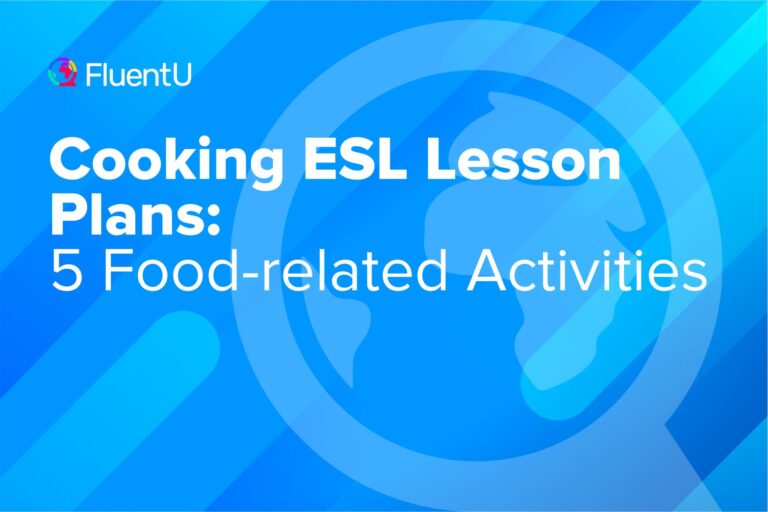Teaching Slang: Activities and Vocab for ESL Learners

Dude, what’s up?
Nothing much. Just chillin’!
For a native English speaker, the above exchange is easy to understand and is pretty common in everyday casual conversation. But for ESL students, this type of informal English can be a challenge because most students are used to learning proper, textbook English.
Discover five different slang activities below to teach informal English in your ESL class in a fun and easy way. They can be used individually or together, but feel free to adapt or change these activities according to the level and age of your students.
Download: This blog post is available as a convenient and portable PDF that you can take anywhere. Click here to get a copy. (Download)
1. Matching game
Prepare two lists: one of slang words and another of their definitions or proper English equivalents. Cut these lists into pieces, cutting out the word or phrase for each expression and definition. In class, distribute the pieces to your students.
Once everyone has received a piece of paper, the students must walk around the classroom and try to find the definition to their slang word or the slang word for their definition.
When students think they have a match, they should bring it to you for confirmation. If it’s correct, lay the two pieces out on your desk and ask them to write the expression and definition on the board. Once all the words and definitions have been matched, go over the terms together.
Alternatively, you can set up this activity by cutting up multiple lists of the words and their definitions, and this time, distributing a whole set of expressions and definitions to a group of students. They must then work in their groups to match all the words and definitions. The first group to complete all the matches wins the activity.
Tip: As an added bonus activity, ask your students to come up with a sentence using one of the words on the list.
2. Rewrite the sentences
This lesson is best for reviewing slang words and phrases. You’ll probably need to pre-teach some slang beforehand to have success with this lesson.
To get started, prepare a worksheet of sentences using formal phrases or slang phrases. In class, distribute these worksheets to your students.
Have them work individually or in small groups to rewrite the sentences, translating them from formal English to slang, or vice versa. This will help them exercise their knowledge of slang, as well as learn how to use it correctly in everyday conversations.
Tip: For younger students or learners at a lower level, consider providing a “word bank” from which they can choose the proper phrase to use.
For a challenging, but fun variation of this exercise, turn this activity into a game or competition. Don’t pre-teach the slang phrases. Instead, have your students use contextual clues to come up with answers. In this case, it’ll be very important to make sure everyone knows the correct answers at the end.
3. Fill in the missing slang
This activity will help students practice using the various slang words and phrases they’ve learned in class.
You’ll need to take some time before class to properly prepare this activity. You can write your own story, or you can find stories online. For example, the story “Red Flowers Make Her See Red” has the phrase “to be through” which means “done,” as well as “got it?”—slang for “Do you understand?”
The story also lends itself to rewriting and you could substitute in more slang before you give it to your students.
There are two ways to conduct this lesson: You can either remove all of the slang phrases from the story and leave the spaces blank, or highlight various words and phrases so that students can easily spot them and translate them into their slang versions. Whichever route you take, don’t forget to make copies of the story to bring to class.
Tip: For younger classes, consider providing a “word bank” where you list the various slang phrases that should appear in the story.
Once you’ve passed out the story, have the students work individually or in small groups of three or four where they’ll read the story to themselves. In the first version of the activity, students should fill in the missing slang words and phrases. If you opt for the second version, students should translate the highlighted phrases into slang.
For example, if the story starts out with “We studied all night, but still barely passed the test” the students should replace the bolded phrases with “We crammed.” Save time at the end of the lesson to share and go over the correct answers.
Tip: If writing your own story, make sure you use the slang words in a way that requires different conjugations and tenses for an added element of English grammar practice.
4. Create your own dialogue
This is a fun way to get your students speaking and practicing slang in a more realistic setting.
Divide students into pairs or small groups. Assign each group a handful of the slang words you’ve covered in previous lessons. Instruct the students to create a dialogue or short skit that includes their assigned slang words. Every student should have a speaking role and the words should be used correctly.
Tip: You may want to have the students write down their dialogues or skit scripts so you can collect them and check for spelling and grammar.
Save time at the end of the lesson for the students to perform their dialogues or skits. Make sure you review any mistakes the students make for the whole class to learn from.
5. Listen for the slang
American TV shows are littered with slang. Watching an episode of your favorite sitcom or drama will reveal just how common slang actually is in day-to-day situations. Your students will enjoy learning about slang by watching some American TV.
Show an episode of an American TV show, like “How I Met Your Mother”—which has frequent examples of “awesome” and “What’s up?”—or “The Big Bang Theory.” Both are filled with common slang words and phrases. The idea is to find an episode that has a lot of examples of slang. Just remember to watch the episode or video yourself before teaching the lesson so that you can take note of all the uses of slang.
Before introducing the video to your students, it’s a good idea to pre-teach or familiarize the students with the phrases they’ll come across in the episode. As students encounter various words and phrases, instruct them to write down all the examples of slang they hear and how often it appears in the episode as they watch the show.
At the end of the video or episode, discuss what the students discovered. Determine whether they were able to find all the slang words and phrases. If there are phrases they don’t understand, provide them with sample sentences providing the context in which the slang is used.
If you’re pressed for time, you can find shorter clips of American TV shows on FluentU, a program with built-in learning features.
FluentU takes authentic videos—like music videos, movie trailers, news and inspiring talks—and turns them into personalized language learning lessons.
You can try FluentU for free for 2 weeks. Check out the website or download the iOS app or Android app.
P.S. Click here to take advantage of our current sale! (Expires at the end of this month.)

Useful Slang Terms for ESL Students
Now that we’ve looked at how to teach slang, let’s look at some commonly used words and phrases students are likely to encounter as they chat with English speakers.
Awesome
Means “cool,” “excellent” or, more literally, “inspiring awe.” It’s particularly useful for younger students who may find themselves interacting with teenagers and peers in English-speaking countries.
It was such an awesome movie!
What’s up?
This is another way to ask “What’s happening?” or “What’s worrying you?”
Commonly used by native English speakers around the world, this phrase is useful for all ESL students, not just adolescents.
A: Hey, John, what’s up?
B: Oh, nothing much!
Hang out
Meaning “spend time relaxing or having fun with others.” It’s important for ESL students to become familiar with this phrase as it is very common in social situations and useful for making invitations.
We should hang out together sometime.
Cool
Informally, this means “excellent” or can be used to express agreement. Though very informal, this term is common in casual conversation among young English speakers.
A: Do you want to go with me to the beach?
B: Yeah, cool! I love the beach.
To bail
This word has several formal meanings, but in slang, it means “to leave.” Point out to your students how some words have both formal and informal meanings.
This party is boring. Let’s bail.
To cram
A great phrase for students, “cram” means “to study a lot in a short amount of time.” This expression is something they might be able to relate to as English students!
I’ve got a lot of cramming to do. My test is tomorrow morning.
Screw up
“Screw up” can be used as a verb meaning “to fail” or as a noun which is “someone who messes up or makes mistakes all the time.” Remember that it’s important to teach students all variations or forms of the word or phrase.
I definitely screwed up that interview.
Bucks
“Bucks” is another word for money, which is commonly used in the United States. ESL students need to be familiar with the different phrases used in transactions. It will help them immensely in day-to-day life in an English-speaking country.
The shirt costs 20 bucks.
ASAP
ASAP is an acronym for “as soon as possible,” and it means “quickly.” This term is especially useful for business English students and professionals.
Let me know if you’re coming to the party ASAP.
Chill
This word means “to calm down.” It’s often used when trying to calm someone down. Again, this term will be more relevant for your young ESL students.
Chill. It’s not a big deal.
Dead
This word means “empty” or “quiet.” In general, this is simply a word that can cause a lot of confusion if all of its meanings are not fully understood. You don’t want your students to mistakenly think that someone died.
It was a Monday night and the restaurant was dead.
Come on
This phrase is often used to express frustration. It can often cause confusion if students aren’t familiar with its various meanings. You should also point out that in the case of this phrase, as with many phrases in English, the tone of the speaker can also help indicate the correct meaning.
“Come on!” in a cheery voice might mean the speaker wants you to follow them. “Come on!” in an angry voice typically doesn’t require the listener to follow the speaker.
Oh, come on! I know you’re lying.
FYI
Again, this is another useful acronym for students to learn. It stands for “for your information.” It’s useful for both younge ESL students and business English students.
FYI, I’m going to be about 30 minutes late.
LOL
This acronym or slang word stands for “laugh out loud” and is used when something is really funny. While it’s commonly found only in written form, English speakers have been known to say it out loud, too, and ESL students should be made aware of it.
My brother was so tired he just fell asleep at the table. LOL.
OMG
OMG stands for “Oh my God!” It’s an exclamation that expresses disbelief or excitement. This phrase is certainly more relevant for young ESL students.
OMG, I got into Harvard!
My bad
This expression is very useful for when students do something wrong and want to give a lighthearted apology. It lets the speaker claim responsibility for a mistake.
A: Where were you? The movie started an hour ago.
B: My bad! I got lost.
No problem
ESL students should become familiar with this phrase as it is used very frequently by native speakers. It is used to express agreement and is sometimes used in place of “you’re welcome.”
A: Thank you for your help today!
B: No problem! Anytime.
Rip-off
“Rip-off” means “overcharge” or “cheated.” Students who plan to travel abroad should know this phrase.
The taxi driver ripped me off.
Twenty-four seven
Sometimes written as 24/7, this phrase is useful for describing something that is always open or always working. It literally means 24 hours a day, 7 days a week. As it’s used quite frequently to describe services and stores, students should be aware of it.
The convenience store is open twenty-four seven.
Kudos
“Kudos” can be used when giving praise or congratulations. In fact, you could help students become more familiar with it by incorporating it into your daily lessons.
Kudos to those who finished their homework on time!
Gotcha
“Gotcha” in slang expresses understanding and comprehension. As it is a very informal phrase, it is probably best to remind students that this word only features in casual conversations. Still, it’s common to hear “gotcha” come up in the workplace, at school and in discussions among friends.
A: I need you to buy milk on your way home.
B: Gotcha. No problem.
Bestie
Students can use this word when talking about their best friends in an informal conversation.
This is my bestie, Sarah.
YOLO
Short for “you only live once,” YOLO means that you should take a chance and do whatever it is you want to do because you only have one life. It’s often used as an exclamation of encouragement or like a motto. This word has had a rather vibrant social media life and your students may already be familiar with it. In any case, it’s important to mention it so students don’t run into any confusion.
I’m going to spend all my savings on traveling in Asia this summer because… YOLO!
Broke
“Broke” expresses the idea that you don’t have any money. Useful for students of any age and level who may find themselves in an English conversation where they have to understand someone’s financial situation or explain their own.
I’m completely broke. I need a second job.
Blow it off
To “blow it off” means to avoid someone or something. Students may find this term helpful for describing social situations.
I felt bad about blowing off that meeting with my advisor, but I was so tired. I’ll send him an email.
On the house
If something is “on the house” it means something is free of charge. Students should become familiar with this phrase especially if they plan on traveling to English speaking countries.
Here. Have another cup of coffee- on the house!
Split
Another slang word for “to leave.” This phrase is very informal, but in order to understand casual conversations more easily, students should learn this word.
It’s getting late. Let’s split.
Pretty
This word has many meanings. In slang, it is often used as an adverb meaning “to a high degree” or “fairly,” and your students will hear it all the time, so it’s important for them to understand how to use it.
I’m pretty sure she said left, not right.
There are dozens of slang words in the English language. You can start with these and add more to your lessons as you come across them.
By teaching your students just a few slang words, you’re helping them learn how to speak English naturally as they hold casual conversations with friends and colleagues.
Download: This blog post is available as a convenient and portable PDF that you can take anywhere. Click here to get a copy. (Download)
And One More Thing...
If you like learning English through movies and online media, you should also check out FluentU. FluentU lets you learn English from popular talk shows, catchy music videos and funny commercials, as you can see here:
The FluentU app and website makes it really easy to watch English videos. There are captions that are interactive. That means you can tap on any word to see an image, definition, and useful examples.
For example, when you tap on the word "searching," you see this:
Learn all the vocabulary in any video with quizzes. Swipe left or right to see more examples for the word you’re learning.

FluentU helps you learn fast with useful questions and multiple examples. Learn more.
The best part? FluentU remembers the vocabulary that you’re learning. It gives you extra practice with difficult words—and reminds you when it’s time to review what you’ve learned. You have a truly personalized experience.
Start using the FluentU website on your computer or tablet or, better yet, download the FluentU app from the iTunes or Google Play store. Click here to take advantage of our current sale! (Expires at the end of this month.)










